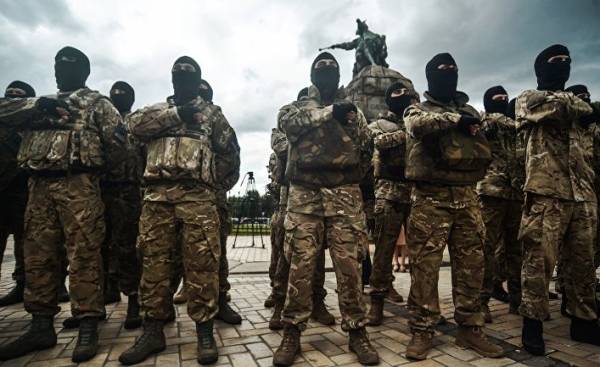
After the Maidan politically motivated non-state actors that act in parallel with the Ukrainian government began to play an extremely important role in ensuring security. While some of them actively cooperated with the Ukrainian authorities, others have repeatedly emerged and continue to emerge, the conflict with the Ukrainian armed forces and Ministry of internal Affairs that, in General, leads to a weakening official security structures in the Ukrainian government. The impression that political and military authority sometimes inseparable from each other, as many commanders of battalions are both career politicians or members of Parliament.
The phrase “volunteer battalion” has become a fairly common term in Ukraine after the Maidan. Although this term may seem rather simple and clear to anyone who is even slightly familiar with the peculiarities of the conflict in the East of Ukraine, it is possible to identify many groups who today are active or idle in the area of anti-terrorist operation (ATO). In fact, these formations can be divided into two groups according to those who support them: those militias whose main patron is the government, represent the officially recognized form, and those that rely on civil society are independent units.
Tensions and conflicts in the relations with the government and long-term relations with political organizations is the result of random, and sometimes non-existent attempts to reorganize — raise the question of the loyalty of these groups. If you let things get out of control, some of these may significantly weaken the legitimacy of the Ukrainian security institutions.
The basis of this serious problem facing Kiev, is his excessive arrogance, and to some extent the ambivalence of the Ukrainian people to security institutions. From the very beginning of the conflict in the Donbass ultra-nationalist groups acted completely independently of the government, and although many of them already demobilized, entered into a formal security structure, or simply disintegrated, some still active. The two largest formations, the epitome of this phenomenon is Ukrainian Volunteer corps “Right sector” (AQL) (banned organization in Russia — approx. ed.) and units of the Ukrainian Volunteer army (UDA) (banned in Russia — approx. TRANS.). Although they have common roots, they diverge in how they interact with the government.
At the end of March 2015, after a long time after all illegal militias were ordered to lay down their arms, “the Right sector” were ordered to leave the seaside city of Mariupol and ATO. “Right sector”, who believed that he had made with the Ministry of defence agreement regarding its presence in the area of ATO, found this treacherous order. A few months later there was a fighting collision between “Right sector” and Ukrainian authorities.
After a confrontation between the AQL and the police at the end of the 2015 MP and former leader of the “Right sector” Dmitry jarosz left the “Right sector”. He took with him the fifth and eighth battalions DUK and created of them the Ukrainian volunteer army (UDA) under the aegis of his own new party. Soon after, the AQL structure has undergone almost complete dissolution for the purpose of conducting large-scale reforms. His leadership has set out to create a small number of active combat units and to divide rather large reserve forces for hundreds.
Compared to DUK units of the Ukrainian volunteer army of Dmitry Yarosh and his political party “the Action” support a closer relationship with the Ukrainian government. Two combat battalion UDA and its medical battalion receive funding through civic initiatives, which allows them to receive all that you may need a light infantry battalion. These initiatives are funded by private donations. Compared to other volunteer groups UDA maintains exceptionally good relations with the official Ukrainian forces, and sometimes she even invites units of the Ukrainian armed forces to their bases to conduct joint military exercises.
No less interesting is the Organization of Ukrainian nationalists (OUN) (banned in Russia — approx. ed.) and its volunteer battalions. After a long confrontation with the 93rd separate mechanized brigade of the Ukrainian armed forces in the village of Sands in 2015, the OUN agreed to hand over the command of part of his battalion and allowing it to enter into the formal security structures of Ukraine under the leadership of the Ministry of defence. The composition of this specific team also included some other first independent volunteer corps, such as the unit “Carpathian Sich”, which is closely associated with the political party “Svoboda”. However, this unit continues to maintain relations with the OUN, which is one of the oldest nationalist organizations of Ukraine and which for the last century, there were many differences and tensions.
However, the relations between the OUN and the Ukrainian government, most likely based rather on convenience than loyalty. Although the volunteer battalion OUN executes the orders of the Ukrainian armed forces, he is still working on the terms of self-organization, and soldiers from other units of the Ukrainian land forces cannot move this unit. Like DUK “Right sector” Yarosh and UDA, volunteer detachments of the OUN are funded by private donations, have their own training program and have their own rehabilitation centers. In addition, OUN maintains its own backup hundreds like hundreds AQL, which do not always obey the Ministry of defense.
OUN as an organization in conflict with the Ukrainian government, and may 9, 2017, the soldiers of the National guard went to storm the headquarters of the OUN in Kiev. Inside the building were members of the “assault corps” of the OUN, who in the summer of 2016 in an informal way moved to the territory of Donbass. It is planned that this summer is this volunteer battalion OUN will begin its first official deployment for a period of approximately three months. However, still questions about informal paramilitary elements of the organization, as well as whether she is again going to conflict with the government.
First, the units of the Ministry of internal Affairs constituted the majority of the units of regular troops in the ATO zone, but now they were in the minority, because in their place came the teams of the Ministry of defence. The national guard of Ukraine — a kind of gendarmerie, receiving funding from the Ministry of the interior — includes one of the most valuable and politically active units that to date have arisen as a result of the conflict.
In particular, the 18th regiment of operational use of the National guard can be attributed to the category of groups of the far-right bias, since it includes battalions “Azov” and “Donbass”. Due to growth of their popularity, these groups have managed to seize the initiative and expand their powers beyond that considered normal for ordinary units of the national guard. It was able to achieve this due to the mistrust of people in state institutions. In 2016 the volunteer corps took second place in the list of institutions that people trust most, second only to the Church.
“Azov” — probably the most famous battalion in the conflict — has grown significantly since its creation. This growth is reflected not only in its function as a paramilitary force, but in its function as a platform for civic, political and “uncivil” society. “Azov” as a “brand” consists of three main elements — the same government (the battalion “Azov”) and two non-governmental. Non-governmental institutions are playing a very significant role in Ukrainian society, and last year they managed to acquire a bad reputation. 12 Oct 2016 private press corps of “Azov” declared that October 14 would be of a political party “national corpus”, which was formed on the basis of already existing organizations “Civil case “Azov””. “Civil case “Azov” and the national case is” closely connected with “Azov”, which itself was the product of civil society.
“Civil case “basics”” how the organization works with at least 2015, and its members call themselves activists. However, the “Civil case” has gained notoriety because of the operations which he conducted against certain private organizations. Despite the bad press, “Civil case” has a number of positive functions normally associated with the activities of civil society: its members hold self defense classes, send out storm warnings, visit animal shelters and so on. Meanwhile, the “Civil case “Azov”” also organized a protest against private and public entities.
One of such actions took place at the building construction company “Kyivmiskbud”: then members of the corps did not allow employees to come into the building because “Azov” decided that the company violates some kind of code, be it moral or legal. However, the activities of this corps reached its peak in March 2017, when members of the “Civil case “the basics”” with the assistance of members of other groups surrounded by a wall of the building branch of the Russian Sberbank in Kiev, so that it was impossible to get. This was the culmination of a long series of attacks and protests against the activities of the savings Bank, organized by activists of the “Civil case “Azov””. They explained their actions by the fact that the Bank allegedly secretly supports separatist movement in the East of the country. Organization, closely linked with military institutions in Ukraine, often invoke this argument to justify their actions.
Separate battalion of special purpose “Donbass” under the direction of battalion commander and people’s Deputy of the Verkhovna Rada semen Semenchenko currently has also become a source of controversy because of its ties with the continued blockade of separatist-held areas. Semenchenko previously clashed with the Ukrainian government. He is known for his frankness and forthrightness from those times when he publicly criticized the leadership of the Ukrainian armed forces for the massacre at Ilovaisk. Semenchenko himself began the siege in January 2017 with the support of the demobilized soldiers of the battalion “Donbass” and activists.
There are suspicions that the blockade was financed by Igor Kolomoisky is a Ukrainian oligarch who provided funds for the ATO. The blockade were met with strong resistance from the establishment of the Ukrainian security structures, who called it a powerful destabilizing factor in an already unstable relations between Ukraine and the separatist regions. Kiev has called this action a “populist”. In the end, the Ukrainian police tried to disperse the protest by force, but failed. And when the militia was nationalized industrial enterprises located in their territories, the authorities accepted the blockade and adopted it as official policy.
In June 2017, the veterans of the battalion “Donbass” under the command of Semenchenko and veterans of the OUN and of the battalion “Aydar” — went to help a group of farmers from the village Berezhynka, who claimed that they want to take away their land and that these are members of the political party “people’s front”, the Minister of internal Affairs Avakov, and others. Shortly after the arrival of “Donbass”, there came the soldiers of the national guard and other special forces of the Ministry of internal Affairs who detained all the participants.
This was not the first time that the national guard has to intervene to put an end to such acts. In fact, friction between the Ministry of internal Affairs and volunteer groups slowly increase. This confirms the fears of many of those who joined the National guard of Ukraine after it was re-established in 2014 — concerns that the guard force can be used against their interests as well as previously used force “Berkut”.
Regardless of relationship to volunteer battalions in Ukraine, they represent a dilemma for the Ukrainian government. The Ukrainian people are now much more confidence in volunteer groups than those institutions that need to manage them. These groups also compete with the government for a monopoly on legalized violence. Many signs points to the fact that Avakov and the establishment of the Ukrainian security structure intended to solve this problem. However, it is possible to solve this problem in a society that had to give up on the promises and expectations of the Maidan, already too late.
Michael Sheldon is a graduate of the University of Malmo, specializing in the study of the conflict in Eastern Ukraine.







